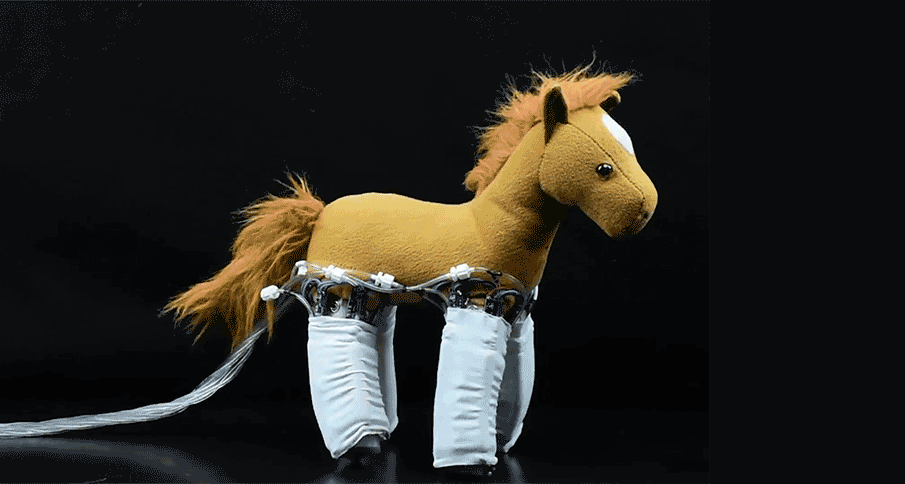Soft robots get their power from the skin they’re in
Given bendy, stretchy skin, everyday objects can morph into useful — or just adorable — robots

A new bendable, stretchable skin can wrap around inanimate objects — such as this stuffed horse’s legs — creating a soft robot.
J.W. Booth et al./Sci Robotics 2018
A new type of soft robot gets its power from the skin it’s in.
This robotic skin bends, stretches and contracts. That flexibility lets it wrap around inanimate objects. Wrap it around the legs of a stuffed animal and presto! A flexible lightweight robot. Putting removable, reusable sheets of this “skin” on other objects could turn them into useful grippers or wearable devices. Researchers described their new invention online September 19 in Science Robotics.
“It’s an interesting approach,” says Christopher Atkeson. He’s a roboticist at Carnegie Mellon University in Pittsburgh, Pa., who did not work on the project. Sometimes it might be simpler to use a soft ready-made robot for a specific purpose. Like squeezing through tight spaces, for example, or gently grabbing objects. The new robotic skins might come in handy for other things, such as search-and-rescue operations or space exploration. These are missions where users might not know in advance what types of robotic helpers they’ll need. They also are missions where packing light is key, Atkeson notes.
Each piece of robotic skin is made of an elastic polymer (PAHL-ih-murr) or fabric. That stretchy skin can hold air pouches that inflate when pumped full of gas. Or it might hold nickel titanium (Ty-TAY-nee-um) coils that contract when heated by an electric current. Such gas pouches or coils would allow the robotic skin to move and change shape.
Rebecca Kramer-Bottiglio is an engineer at Yale University in New Haven, Conn. She and colleagues used the skin to build several robots. They gave the robots different types of motion two ways. In one, they changed the layout of air pouches or coils in the skin. For the other, they attached pieces of skin to an object in various ways.
For instance, wrapping the skin around foam tubes in one direction created robots that crawled like inchworms. Wrapping it another direction created robots that paddled forward on two ends. Patches of robotic skin around three foam fingers created a soft robot “grabber.”
The researchers also fastened robotic skin to a shirt to create a garment that monitors posture. Whenever the skin sensed the user’s shoulders slumping, it wriggled gently as a reminder to sit up straight. Robotic skin stitched into clothing could give the wearer a massage. Or it could provide tactile (touch) feedback in virtual reality systems, Atkeson says.
The robotic skin isn’t ready for off-the-shelf use just yet. To work, each piece must be tethered to hoses or wires. These feed into its gas pouches or electric coils. But future versions might include portable air pressure and electricity devices, Kramer-Bottiglio says.







